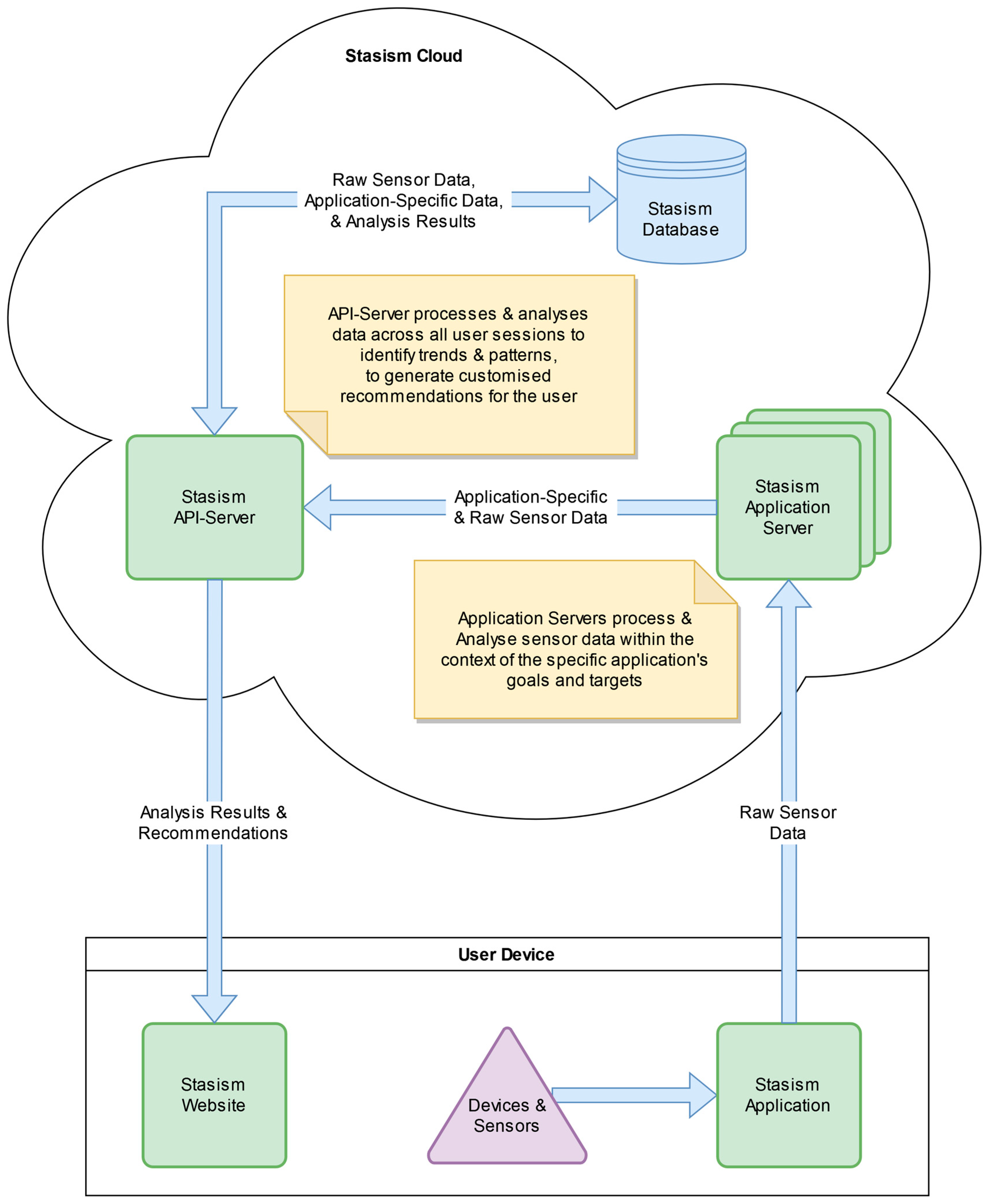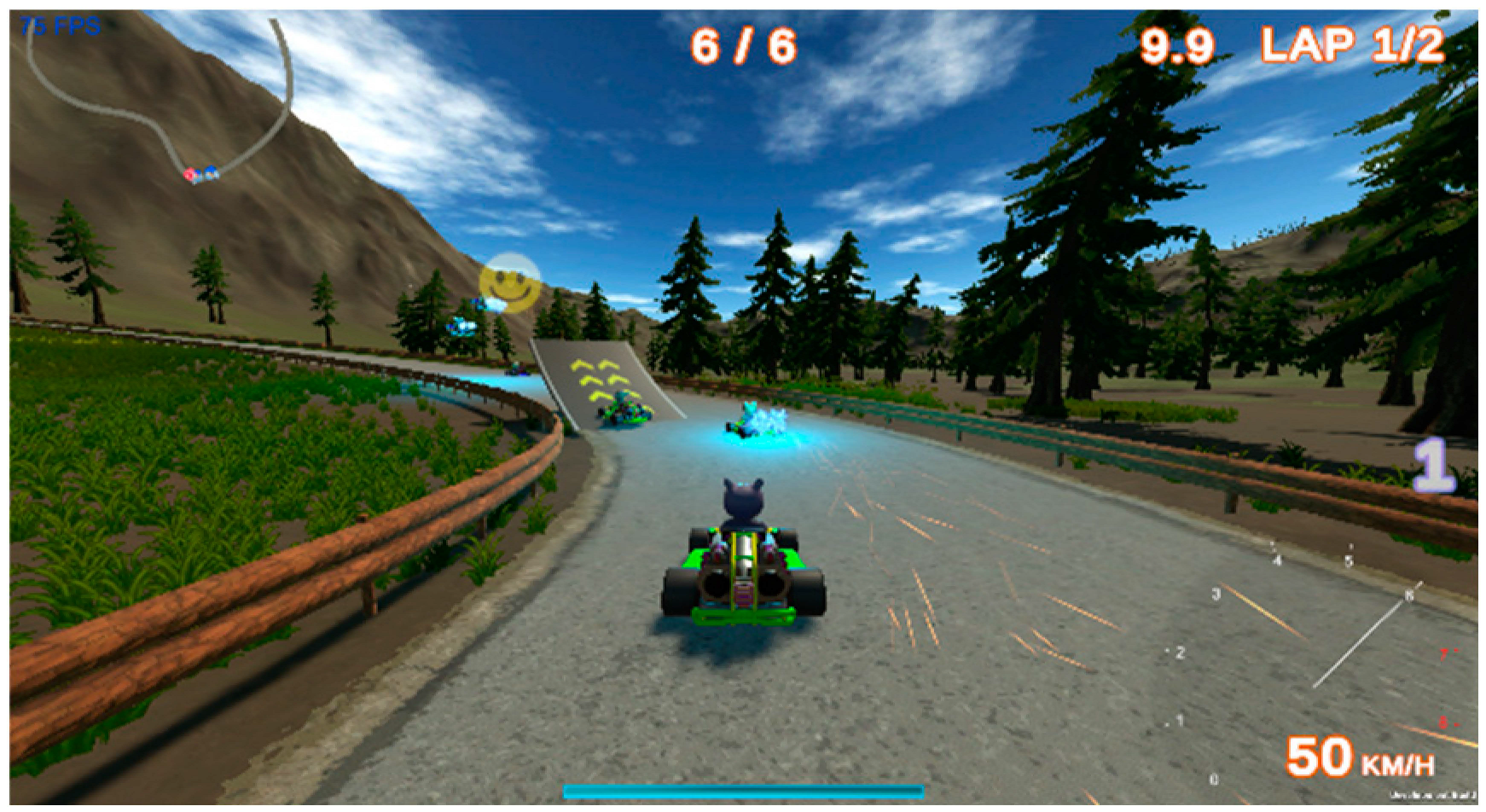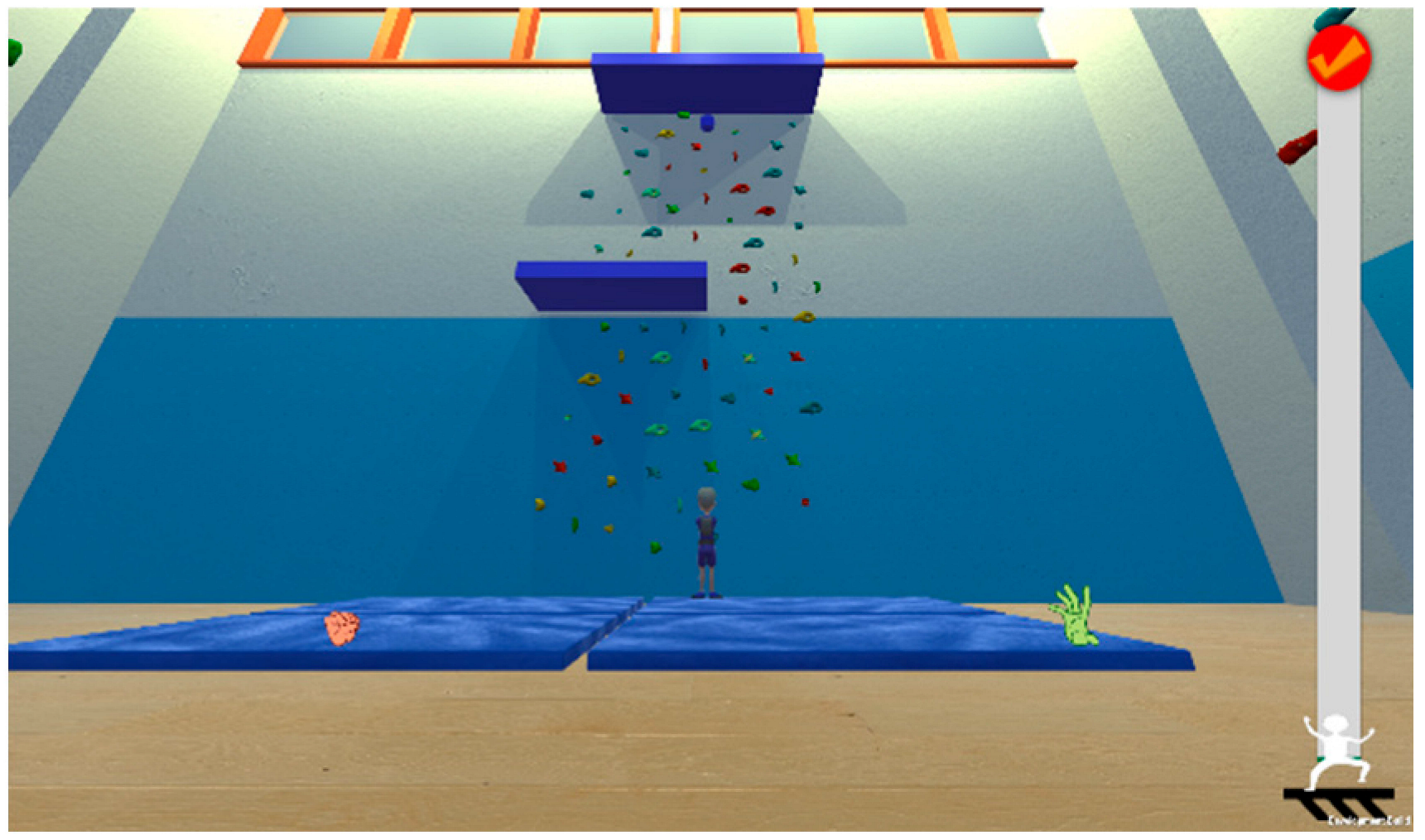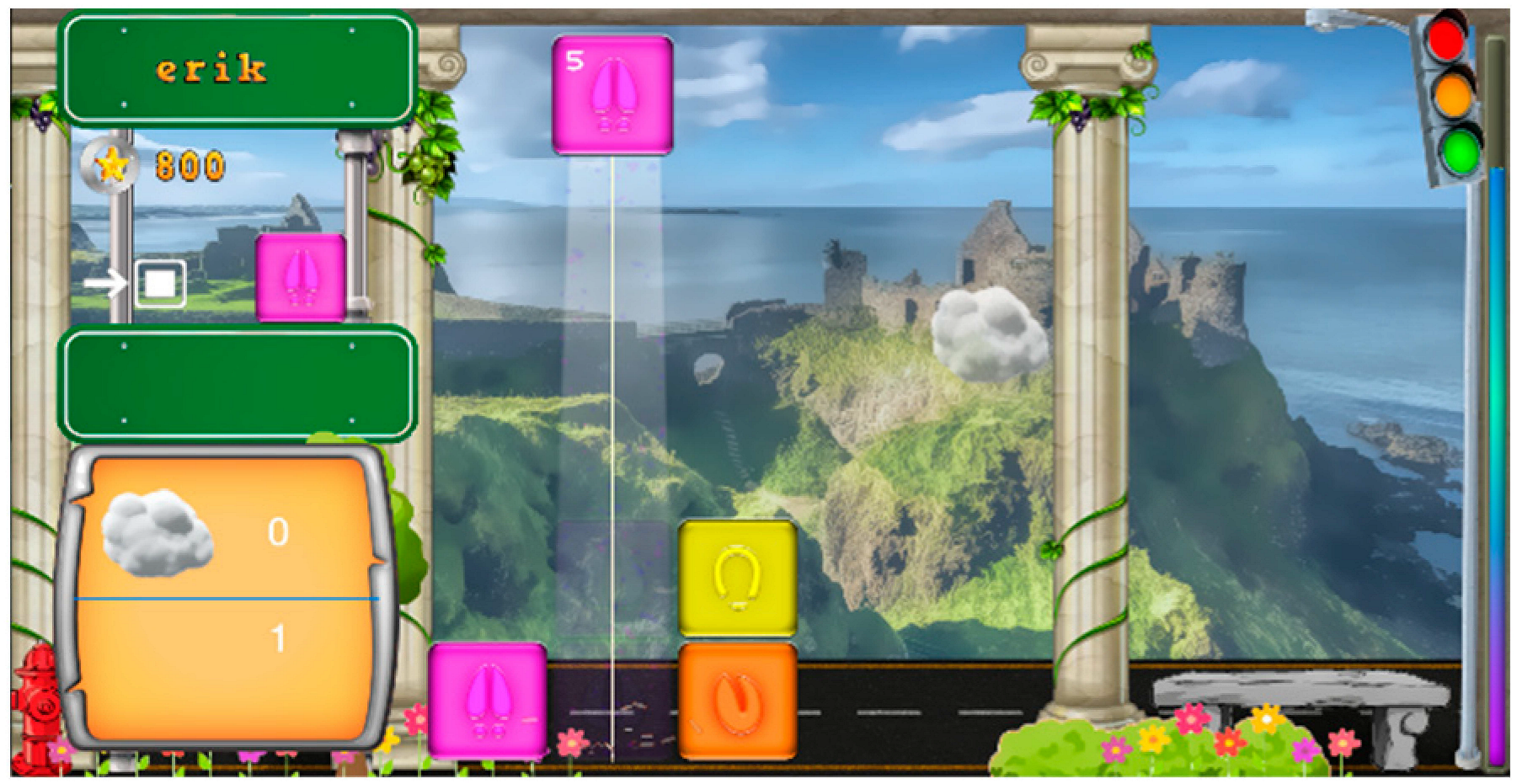STASISM: A Versatile Serious Gaming Multi-Sensor Platform for Personalized Telerehabilitation and Telemonitoring
Abstract
1. Introduction
2. Development and Validation of the Platform
2.1. A Multidisciplinary Consortium
2.2. Piloting across Diverse Contexts
2.2.1. Cultural Diversity
2.2.2. Economic Diversity
2.2.3. Adaptability and Inclusivity
2.3. Listening to User Feedback
2.4. Ongoing System Enhancement
3. The Platform: STASISM
3.1. Hardware
3.2. Architecture of the Data Collection
3.3. Security of Patient Data and Data Privacy
- The real-world identity of the patient is not stored within our system. The responsibility lies with the clinic to link the STASISM account with the patient’s identity.
- Rigorous adherence to GDPR standards is maintained, with a dedicated data protection officer (DPO) overseeing the handling of all data.
- In compliance with EU regulations, all data are stored exclusively within the European Union.
- Stringent security measures are applied to all traffic to and from the server, ensuring encryption for enhanced data protection.
- The database itself is encrypted, providing an additional layer of security to safeguard stored information.
- A robust security protocol is in place, where all logins are fortified with two-factor authentication (2FA), bolstering the integrity of user access and further securing the system against unauthorized entry.
3.4. Therapeutic Programs
3.5. (Tele) Rehabilitation Exercises
3.6. Serious Games
3.7. Third-Party Games
3.8. Assessment Tools
3.8.1. Static Balance Test
3.8.2. The Dynamic Balance Test (DBT)
3.8.3. Ranges of Motion
3.8.4. Rapid Measure Tool
3.9. Advance Analytics
3.10. Clinical Validation of the System
3.11. Comparisons with Commercial Systems
4. Discussion
5. Conclusions
Author Contributions
Funding
Institutional Review Board Statement
Informed Consent Statement
Data Availability Statement
Conflicts of Interest
References
- Cieza, A.; Causey, K.; Kamenov, K.; Hanson, S.W.; Chatterji, S.; Vos, T. Global Estimates of the Need for Rehabilitation Based on the Global Burden of Disease Study 2019: A Systematic Analysis for the Global Burden of Disease Study 2019. Lancet 2021, 396, 2006–2017. [Google Scholar] [CrossRef] [PubMed]
- Stinear, C.M.; Lang, C.E.; Zeiler, S.; Byblow, W.D. Advances and Challenges in Stroke Rehabilitation. Lancet Neurol. 2020, 19, 348–360. [Google Scholar] [CrossRef] [PubMed]
- Wade, D.T. What Is Rehabilitation? An Empirical Investigation Leading to an Evidence-Based Description. Clin. Rehabil. 2020, 34, 571–583. [Google Scholar] [CrossRef] [PubMed]
- Barker-Davies, R.M.; O’Sullivan, O.; Senaratne, K.P.P.; Baker, P.; Cranley, M.; Dharm-Datta, S.; Ellis, H.; Goodall, D.; Gough, M.; Lewis, S.; et al. The Stanford Hall Consensus Statement for Post-COVID-19 Rehabilitation. Br. J. Sports Med. 2020, 54, 949–959. [Google Scholar] [CrossRef] [PubMed]
- Alonazi, A. Effectiveness and Acceptability of Telerehabilitation in Physical Therapy during COVID-19 in Children: Findings of a Systematic Review. Children 2021, 8, 1101. [Google Scholar] [CrossRef] [PubMed]
- Ackerley, S.; Wilson, N.; Boland, P.; Read, J.; Connell, L. Implementation of Neurological Group-Based Telerehabilitation within Existing Healthcare during the COVID-19 Pandemic: A Mixed Methods Evaluation. BMC Health Serv. Res. 2023, 23, 671. [Google Scholar] [CrossRef]
- Bickenbach, J.; Sabariego, C.; Stucki, G. Beneficiaries of Rehabilitation. Arch. Phys. Med. Rehabil. 2021, 102, 543–548. [Google Scholar] [CrossRef]
- Angeli, J.M.; Schwab, S.M.; Huijs, L.; Sheehan, A.; Harpster, K. ICF-Inspired Goal-Setting in Developmental Rehabilitation: An Innovative Framework for Pediatric Therapists. Physiother. Theory Pract. 2019, 37, 1167–1176. [Google Scholar] [CrossRef]
- Bright, T.; Wallace, S.; Kuper, H. A Systematic Review of Access to Rehabilitation for People with Disabilities in Low- and Middle-Income Countries. Int. J. Environ. Res. Public Health 2018, 15, 2165. [Google Scholar] [CrossRef]
- Bernhardt, J.; Urimubenshi, G.; Gandhi, D.B.C.; Eng, J.J. Stroke Rehabilitation in Low-Income and Middle-Income Countries: A Call to Action. Lancet 2020, 396, 1452–1462. [Google Scholar] [CrossRef]
- Boma, P.M.; Panda, J.; Ngoy Mande, J.P.; Bonnechère, B. Rehabilitation: A Key Service, yet Highly Underused, in the Management of Young Patients with Sickle Cell Disease after Stroke in DR of Congo. Front. Neurol. 2023, 14, 1104101. [Google Scholar] [CrossRef] [PubMed]
- Bravi, M.; Longo, U.G.; Laurito, A.; Greco, A.; Marino, M.; Maselli, M.; Sterzi, S.; Santacaterina, F. Supervised versus Unsupervised Rehabilitation Following Total Knee Arthroplasty: A Systematic Review and Meta-Analysis. Knee 2023, 40, 71–89. [Google Scholar] [CrossRef] [PubMed]
- Berton, A.; Longo, U.G.; Candela, V.; Fioravanti, S.; Giannone, L.; Arcangeli, V.; Alciati, V.; Berton, C.; Facchinetti, G.; Marchetti, A.; et al. Virtual Reality, Augmented Reality, Gamification, and Telerehabilitation: Psychological Impact on Orthopedic Patients’ Rehabilitation. J. Clin. Med. 2020, 9, 2567. [Google Scholar] [CrossRef] [PubMed]
- Chanpimol, S.; Benson, K.; Maloni, H.; Conroy, S.; Wallin, M. Acceptability and Outcomes of an Individualized Exergaming telePT Program for Veterans with Multiple Sclerosis: A Pilot Study. Arch. Physiother. 2020, 10, 18. [Google Scholar] [CrossRef] [PubMed]
- Alfieri, F.M.; da Silva Dias, C.; de Oliveira, N.C.; Battistella, L.R. Gamification in Musculoskeletal Rehabilitation. Curr. Rev. Musculoskelet. Med. 2022, 15, 629–636. [Google Scholar] [CrossRef]
- Pimentel-Ponce, M.; Romero-Galisteo, R.P.; Palomo-Carrión, R.; Pinero-Pinto, E.; Merchán-Baeza, J.A.; Ruiz-Muñoz, M.; Oliver-Pece, J.; González-Sánchez, M. Gamification and Neurological Motor Rehabilitation in Children and Adolescents: A Systematic Review. Neurologia (Engl. Ed.) 2021, in press. [Google Scholar] [CrossRef]
- Fendt-Newlin, M.; Jagannathan, A.; Webber, M. Cultural Adaptation Framework of Social Interventions in Mental Health: Evidence-Based Case Studies from Low- and Middle-Income Countries. Int. J. Soc. Psychiatry 2020, 66, 41–48. [Google Scholar] [CrossRef]
- Winskell, K.; Sabben, G.; Akelo, V.; Ondeng’e, K.; Obong’o, C.; Stephenson, R.; Warhol, D.; Mudhune, V. A Smartphone Game-Based Intervention (Tumaini) to Prevent HIV among Young Africans: Pilot Randomized Controlled Trial. JMIR mHealth uHealth 2018, 6, e10482. [Google Scholar] [CrossRef]
- Amorim, P.; Paiva, J.; Silva de Lima, J.; Portugal da Fonseca, L.; Martins, H.; Silva, P.A. Lessons Learned from Investigating Patients’ and Physiotherapists’ Perspectives on the Design of a Telerehabilitation Platform. Disabil. Rehabil. Assist. Technol. 2023, 1–12. [Google Scholar] [CrossRef]
- Suso-Martí, L.; La Touche, R.; Herranz-Gómez, A.; Angulo-Díaz-Parreño, S.; Paris-Alemany, A.; Cuenca-Martínez, F. Effectiveness of Telerehabilitation in Physical Therapist Practice: An Umbrella and Mapping Review with Meta-Meta-Analysis. Phys. Ther. 2021, 101, pzab075. [Google Scholar] [CrossRef]
- Nonnekes, J.; Nieuwboer, A. Towards Personalized Rehabilitation for Gait Impairments in Parkinson’s Disease. J. Parkinsons. Dis. 2018, 8, S101–S106. [Google Scholar] [CrossRef] [PubMed]
- Nizeyimana, E.; Joseph, C.; Louw, Q.A. Organizational Readiness and Rehabilitation Professionals’ Views on Integrating Telerehabilitation into Service Delivery and Students’ Clinical Training: A Qualitative Study. Digit. Health 2023, 9, 20552076231212314. [Google Scholar] [CrossRef] [PubMed]
- Gaboury, I.; Dostie, R.; Corriveau, H.; Demoustier, A.; Tousignant, M. Use of a Telerehabilitation Platform in a Stroke Continuum: A Qualitative Study of Patient and Therapist Acceptability. Int. J. Telerehabil. 2022, 14, e6453. [Google Scholar] [CrossRef] [PubMed]
- Chen, T.; Or, C.K.; Chen, J. Effects of Technology-Supported Exercise Programs on the Knee Pain, Physical Function, and Quality of Life of Individuals with Knee Osteoarthritis and/or Chronic Knee Pain: A Systematic Review and Meta-Analysis of Randomized Controlled Trials. J. Am. Med. Inform. Assoc. 2021, 28, 414–423. [Google Scholar] [CrossRef] [PubMed]
- Lumsden, J.; Edwards, E.A.; Lawrence, N.S.; Coyle, D.; Munafò, M.R. Gamification of Cognitive Assessment and Cognitive Training: A Systematic Review of Applications and Efficacy. JMIR Serious Games 2016, 4, e11. [Google Scholar] [CrossRef] [PubMed]
- Van Sint Jan, S.; Wermenbol, V.; Van Bogaert, P.; Desloovere, K.; Degelaen, M.; Dan, B.; Salvia, P.; Ortibus, E.; Bonnechère, B.; Le Borgne, Y.-A.; et al. A technological platform for cerebral palsy—The ICT4Rehab project. Medecine/Sciences 2013, 29, 529–536. [Google Scholar] [CrossRef] [PubMed][Green Version]
- Wagner, A.K. A Rehabilomics Framework for Personalized and Translational Rehabilitation Research and Care for Individuals with Disabilities: Perspectives and Considerations for Spinal Cord Injury. J. Spinal Cord Med. 2014, 37, 493–502. [Google Scholar] [CrossRef] [PubMed]
- Garro, F.; Chiappalone, M.; Buccelli, S.; De Michieli, L.; Semprini, M. Neuromechanical Biomarkers for Robotic Neurorehabilitation. Front. Neurorobot. 2021, 15, 742163. [Google Scholar] [CrossRef]
- Lee, K. Agreement between 3D Motion Analysis and Tele-Assessment Using a Video Conferencing Application for Telerehabilitation. Healthcare 2021, 9, 1591. [Google Scholar] [CrossRef]
- Sholukha, V.; Bonnechere, B.; Salvia, P.; Moiseev, F.; Rooze, M.; Van Sint Jan, S. Model-Based Approach for Human Kinematics Reconstruction from Markerless and Marker-Based Motion Analysis Systems. J. Biomech. 2013, 46, 2363–2371. [Google Scholar] [CrossRef]
- Bonnechère, B.; Sholukha, V.; Omelina, L.; Van Sint Jan, S.; Jansen, B. 3D Analysis of Upper Limbs Motion during Rehabilitation Exercises Using the KinectTM Sensor: Development, Laboratory Validation and Clinical Application. Sensors 2018, 18, 2216. [Google Scholar] [CrossRef] [PubMed]
- Srivastava, S.; Divekar, A.V.; Anilkumar, C.; Naik, I.; Kulkarni, V.; Pattabiraman, V. Comparative Analysis of Deep Learning Image Detection Algorithms. J. Big Data 2021, 8, 66. [Google Scholar] [CrossRef]
- Bonnechère, B.; Jansen, B.; Van Sint Jan, S. Cost-Effective (Gaming) Motion and Balance Devices for Functional Assessment: Need or Hype? J. Biomech. 2016, 49, 2561–2565. [Google Scholar] [CrossRef] [PubMed]
- Kanzler, C.M.; Rinderknecht, M.D.; Schwarz, A.; Lamers, I.; Gagnon, C.; Held, J.P.O.; Feys, P.; Luft, A.R.; Gassert, R.; Lambercy, O. A Data-Driven Framework for Selecting and Validating Digital Health Metrics: Use-Case in Neurological Sensorimotor Impairments. NPJ Digit. Med. 2020, 3, 80. [Google Scholar] [CrossRef] [PubMed]
- Bonnechère, B.; Jansen, B.; Omelina, L.; Sholukha, V.; Van Sint Jan, S. Validation of the Balance Board for Clinical Evaluation of Balance During Serious Gaming Rehabilitation Exercises. Telemed. J. e-Health 2016, 22, 709–717. [Google Scholar] [CrossRef] [PubMed]
- Van Hove, O.; Van Muylem, A.; Leduc, D.; Jansen, B.; Feipel, V.; Van Sint Jan, S.; Bonnechère, B. Validation of the Wii Balance Board to Assess Balance Modifications Induced by Increased Respiratory Loads in Healthy Subjects. Gait Posture 2019, 68, 449–452. [Google Scholar] [CrossRef]
- Barry, E.; Galvin, R.; Keogh, C.; Horgan, F.; Fahey, T. Is the Timed Up and Go Test a Useful Predictor of Risk of Falls in Community Dwelling Older Adults: A Systematic Review and Meta-Analysis. BMC Geriatr. 2014, 14, 14. [Google Scholar] [CrossRef]
- Kim, J.-W.; Choi, J.-Y.; Ha, E.-J.; Choi, J.-H. Human Pose Estimation Using MediaPipe Pose and Optimization Method Based on a Humanoid Model. Appl. Sci. 2023, 13, 2700. [Google Scholar] [CrossRef]
- Latreche, A.; Kelaiaia, R.; Chemori, A.; Kerboua, A. Reliability and Validity Analysis of MediaPipe-Based Measurement System for Some Human Rehabilitation Motions. Measurement 2023, 214, 112826. [Google Scholar] [CrossRef]
- Cappozzo, A.; Catani, F.; Della Croce, U.; Leardini, A. Position and Orientation in Space of Bones during Movement: Anatomical Frame Definition and Determination. Clin. Biomech. 1995, 10, 171–178. [Google Scholar] [CrossRef]
- Ali Mohamed, M.; El-henawy, I.M.; Salah, A. Usages of Spark Framework with Different Machine Learning Algorithms. Comput. Intell. Neurosci. 2021, 2021, 1896953. [Google Scholar] [CrossRef] [PubMed]
- Heyrman, L.; Molenaers, G.; Desloovere, K.; Verheyden, G.; De Cat, J.; Monbaliu, E.; Feys, H. A Clinical Tool to Measure Trunk Control in Children with Cerebral Palsy: The Trunk Control Measurement Scale. Res. Dev. Disabil. 2011, 32, 2624–2635. [Google Scholar] [CrossRef] [PubMed]
- Kachmar, O.; Kushnir, A.; Fedchyshyn, B.; Cristiano, J.; O’Flaherty, J.; Helland, K.; Johnson, G.; Puig, D. Personalized Balance Games for Children with Cerebral Palsy: A Pilot Study. J. Pediatr. Rehabil. Med. 2021, 14, 237–245. [Google Scholar] [CrossRef] [PubMed]
- Timocco Fun Therapy Games for Kids with Special Needs. Available online: https://www.timocco.com/ (accessed on 20 December 2023).
- enAble. enAble Games Is an Active Video Game (AVG) Platform that Includes a Suite of Fun and Challenging Games for Players with Disabilities. Available online: https://www.enablegames.com/ (accessed on 20 December 2023).
- Jintronix Interactive Technology for Rehabilitation and Senior Care. Available online: https://jintronix.com/ (accessed on 20 December 2023).
- VAST. Rehab Software for Physical and Occupational Therapists to Create, Track and Optimize Gamified Therapy Sessions for Patients of All Ages. Available online: https://vast.rehab/ (accessed on 20 December 2023).
- Seron, P.; Oliveros, M.-J.; Gutierrez-Arias, R.; Fuentes-Aspe, R.; Torres-Castro, R.C.; Merino-Osorio, C.; Nahuelhual, P.; Inostroza, J.; Jalil, Y.; Solano, R.; et al. Effectiveness of Telerehabilitation in Physical Therapy: A Rapid Overview. Phys. Ther. 2021, 101, pzab053. [Google Scholar] [CrossRef] [PubMed]
- WHO Fact Sheets: Rehabilitation. 2020. Available online: https://www.who.int/news-room/fact-sheets/detail/rehabilitation (accessed on 3 October 2023).
- Ambros-Antemate, J.F.; Beristain-Colorado, M.D.P.; Vargas-Treviño, M.; Gutiérrez-Gutiérrez, J.; Hernández-Cruz, P.A.; Gallegos-Velasco, I.B.; Moreno-Rodríguez, A. Improving Adherence to Physical Therapy in the Development of Serious Games: Conceptual Framework Design Study. JMIR Form. Res. 2023, 7, e39838. [Google Scholar] [CrossRef] [PubMed]
- Kylén, M.; Sturge, J.; Lipson-Smith, R.; Schmidt, S.M.; Pessah-Rasmussen, H.; Svensson, T.; de Vries, L.; Bernhardt, J.; Elf, M. Built Environments to Support Rehabilitation for People with Stroke from the Hospital to the Home (B-Sure): Protocol for a Mixed Method Participatory Co-Design Study. JMIR Res. Protoc. 2023, 12, e52489. [Google Scholar] [CrossRef] [PubMed]
- Lin, D.J.; Stein, J. Stepping Closer to Precision Rehabilitation. JAMA Neurol. 2023, 80, 339–341. [Google Scholar] [CrossRef]
- de Ridder, W.A.; van Kooij, Y.E.; Slijper, H.P.; Arends, G.R.; de Roode, A.; MacDermid, J.C.; Vermeulen, G.M.; Hovius, S.E.R.; Selles, R.W.; Wouters, R.M.; et al. Tailoring and Evaluating Treatment with the Patient-Specific Needs Evaluation: A Patient-Centered Approach. Plast. Reconstr. Surg. 2023, 10–1097. [Google Scholar] [CrossRef]
- Marks, D.; Kitcher, S.; Attrazic, E.; Hing, W.; Cottrell, M. The Health Economic Impact of Musculoskeletal Physiotherapy Delivered by Telehealth: A Systematic Review. Int. J. Telerehabil. 2022, 14, e6524. [Google Scholar] [CrossRef]
- Peretti, A.; Amenta, F.; Tayebati, S.K.; Nittari, G.; Mahdi, S.S. Telerehabilitation: Review of the State-of-the-Art and Areas of Application. JMIR Rehabil. Assist. Technol. 2017, 4, e7. [Google Scholar] [CrossRef]
- Bonnechère, B.; Van Vooren, M.; Bier, J.-C.; De Breucker, S.; Van Hove, O.; Van Sint Jan, S.; Feipel, V.; Jansen, B. The Use of Mobile Games to Assess Cognitive Function of Elderly with and without Cognitive Impairment. J. Alzheimers Dis. 2018, 64, 1285–1293. [Google Scholar] [CrossRef] [PubMed]
- Khanna, D.; Jindal, N.; Singh, H.; Rana, P.S. Applications and Challenges in Healthcare Big Data: A Strategic Review. Curr. Med. Imaging 2022, 19, 27–36. [Google Scholar] [CrossRef] [PubMed]
- Ottenbacher, K.J.; Graham, J.E.; Fisher, S.R. Data Science in Physical Medicine and Rehabilitation: Opportunities and Challenges. Phys. Med. Rehabil. Clin. N. Am. 2019, 30, 459–471. [Google Scholar] [CrossRef] [PubMed]
- Coscia, M.; Wessel, M.J.; Chaudary, U.; Millán, J.D.R.; Micera, S.; Guggisberg, A.; Vuadens, P.; Donoghue, J.; Birbaumer, N.; Hummel, F.C. Neurotechnology-Aided Interventions for Upper Limb Motor Rehabilitation in Severe Chronic Stroke. Brain 2019, 142, 2182–2197. [Google Scholar] [CrossRef] [PubMed]
- RELEASE Collaborators; Brady, M.C.; Ali, M.; VandenBerg, K.; Williams, L.J.; Williams, L.R.; Abo, M.; Becker, F.; Bowen, A.; Brandenburg, C.; et al. Precision Rehabilitation for Aphasia by Patient Age, Sex, Aphasia Severity, and Time since Stroke? A Prespecified, Systematic Review-Based, Individual Participant Data, Network, Subgroup Meta-Analysis. Int. J. Stroke 2022, 17, 1067–1077. [Google Scholar] [CrossRef]
- Parre, M.D.; Sujatha, B. Novel Human-Centered Robotics: Towards an Automated Process for Neurorehabilitation. Neurol. Res. Int. 2021, 2021, 6690715. [Google Scholar] [CrossRef] [PubMed]
- Richards, L.G.; Cramer, S.C. Therapies Targeting Stroke Recovery. Stroke 2023, 54, 265–269. [Google Scholar] [CrossRef]
- Robertson, S.T.; Rosbergen, I.C.M.; Burton-Jones, A.; Grimley, R.S.; Brauer, S.G. The Effect of the Electronic Health Record on Interprofessional Practice: A Systematic Review. Appl. Clin. Inform. 2022, 13, 541–559. [Google Scholar] [CrossRef]
- van der Merwe, A.; Barnes, R.Y.; Labuschagne, M.J. The PIER Framework for Healthcare Simulation Integration in Undergraduate Physiotherapy Education. BMC Med. Educ. 2022, 22, 690. [Google Scholar] [CrossRef]
- Bonnechère, B.; Van Vooren, M.; Jansen, B.; Van Sint, J.S.; Rahmoun, M.; Fourtassi, M. Patients’ Acceptance of the Use of Serious Games in Physical Rehabilitation in Morocco. Games Health J. 2017, 6, 290–294. [Google Scholar] [CrossRef]
- Warmerdam, E.; Hausdorff, J.M.; Atrsaei, A.; Zhou, Y.; Mirelman, A.; Aminian, K.; Espay, A.J.; Hansen, C.; Evers, L.J.W.; Keller, A.; et al. Long-Term Unsupervised Mobility Assessment in Movement Disorders. Lancet Neurol. 2020, 19, 462–470. [Google Scholar] [CrossRef] [PubMed]
- Pang, D.; Sun, A.; Wang, F.; Lu, J.; Guo, Y.; Ding, W. The Efficacy and Safety of Telerehabilitation for Patients Following Total Knee Arthroplasty: A Overviews of Systematic Reviews. Biomed. Eng. Online 2023, 22, 97. [Google Scholar] [CrossRef] [PubMed]
- Neves, L.H.G.; Malaguti, C.; Santos, M.R.; Cabral, L.A.; da Silva, L.B.D.; de Oliveira, H.H.; Brugiolo, A.S.S.; José, A.; Holland, A.E.; Oliveira, C.C. Pulmonary Telerehabilitation for People with Chronic Obstructive Pulmonary Disease in Brazil: A Mixed-Methods Feasibility Study. Int. J. Telerehabil. 2023, 15, e6555. [Google Scholar] [CrossRef] [PubMed]
- Stark, A.L.; Krayter, S.; Dockweiler, C. Competencies Required by Patients and Health Professionals Regarding Telerehabilitation: A Scoping Review. Digit. Health 2023, 9, 20552076231218841. [Google Scholar] [CrossRef] [PubMed]
- Erku, D.; Khatri, R.; Endalamaw, A.; Wolka, E.; Nigatu, F.; Zewdie, A.; Assefa, Y. Digital Health Interventions to Improve Access to and Quality of Primary Health Care Services: A Scoping Review. Int. J. Environ. Res. Public Health 2023, 20, 6854. [Google Scholar] [CrossRef]
- Ha, S.; Ho, S.H.; Bae, Y.-H.; Lee, M.; Kim, J.H.; Kim, J.H.; Lee, J. Digital Health Equity and Tailored Health Care Service for People with Disability: User-Centered Design and Usability Study. J. Med. Internet Res. 2023, 25, e50029. [Google Scholar] [CrossRef]
- Bonnechère, B.; Kossi, O.; Mapinduzi, J.; Panda, J.; Rintala, A.; Guidetti, S.; Spooren, A.; Feys, P. Mobile Health Solutions: An Opportunity for Rehabilitation in Low- and Middle Income Countries? Front. Public Health 2022, 10, 1072322. [Google Scholar] [CrossRef]
- Seebacher, B.; Bergmann, E.; Geimer, C.; Kahraman, T.; Reindl, M.; Diermayr, G. Factors Influencing the Willingness to Adopt Telerehabilitation among Rehabilitation Professionals in Austria and Germany: A Survey Comparing Data before and during COVID-19. Disabil. Rehabil. 2023, 1–9. [Google Scholar] [CrossRef]
- Morrow, C.; Woodbury, M.; Simpson, A.N.; Almallouhi, E.; Simpson, K.N. Determining the Marginal Cost Differences of a Telehealth Versus an In-Person Occupational Therapy Evaluation Session for Stroke Survivors Using Time-Driven Activity-Based Costing. Arch. Phys. Med. Rehabil. 2023, 104, 547–553. [Google Scholar] [CrossRef]


| Component | Requirement |
|---|---|
| OS | Microsoft Windows 10 |
| Memory | 8 GB |
| CPU | 64-bit CPU with 4 cores 3+ GHZ |
| GPU | Nvidia GeForce 950 or equivalent |
| DirectX | Version 11 |
| Storage | 30 GB free |
| Internet | 4G or Broadband |
| Balance Board | STASISM Balance Board |
| Webcam | 1080 p, 60 fps |
| Games | Description | Mode | Visual Adaptation * | Game Outcome | Controller | Therapeutic Targets | Screenshots |
|---|---|---|---|---|---|---|---|
| Crazy Racing | Racing game where the player has a task for each level. The character catches the object, races other cars, and explores different roads. | Single | + | Time Completion Percentage (N of bonus coins) | Balance Board: side and forward-backward sways (standing, sitting, kneeling) Camera (body sways) | Balance function, proprioception, visual-spatial ability, navigation skills, attention |  |
| Crusher | Action game that involves different movements of the body parts to crush buildings and transport with a monster character. | Single | − | Points | Camera (upper body, arms, hands, head, mouth) | Motor coordination, proprioception, gross motor skills, fine motor skills, stress relief |  |
| Dodge Dare | Game with augmented reality: a player moves around their room and dodges the lasers | Single | − | Playing Time N of successful dodges | Camera (3D body movement) | Motor coordination, proprioception, visual-spatial ability, gross motor skills, attention |  |
| Hex | Game where the player controls a witch flying on her broom with their movements. With each level, the character moves faster, explores different environments, and faces various challenges. | Single | + | Playing Time | Camera (hand clench, mouth) | Gross motor skills, fine motor skills, voluntary motor control, attention |  |
| Hungry Woo | Game that revolves around the task of feeding a cat. The main objective is for the player to catch food items while avoiding non-edible objects. As the game progresses, the speed increases and the objects encountered change with each level. | Single, Cooperation, and Player-versus-Player (PvP) | + | Completion Percentage (N of caught edible objects and avoided non-edible objects) | Balance Board: side sways (standing, sitting, kneeling) | Balance function, proprioception, visual-spatial ability, decision-making, object recognition, impulse control |  |
| Paddle Waddle | Action game, where the main goal is to keep balls in motion by rebounding them with a paddle. Along the way, players can collect stars to earn points and progress to higher levels. As the child advances, the ball speed increases, and the new puzzle picture opens. In addition to striving for personal achievements, players can compete against others globally to achieve the highest score and receive rewards for surpassing the existing record. | Single | + | Points | Balance Board: side sways (standing, sitting, kneeling) Camera (body sways, shoulder flexion, shoulder abduction, shoulder rotation, elbow flexion, elbow supination, wrist flexion, hand clench, mouth) | Balance function, proprioception, visual-spatial ability, gross motor function, fine motor skills, voluntary motor control, attention, decision-making |  |
| Pongo Paddle | Variation of the favorite Paddle Waddle game. Action game, where the main goal is to keep balls in motion by rebounding them with a paddle. Along the way, players can collect stars to earn points and progress to higher levels. As the child advances, the ball speed increases, and the new puzzle picture opens. In addition to striving for personal achievements, players can compete against others globally to achieve the highest score and receive rewards for surpassing the existing record. | Single | + | Points | Balance Board: forward-backward sways (standing, sitting, kneeling) Camera (body sways, shoulder flexion, shoulder abduction, shoulder rotation, elbow flexion, elbow supination, wrist flexion, hand clench, mouth) | Balance function, proprioception, visual-spatial ability, gross motor function, fine motor skills, voluntary motor control, attention, decision-making |  |
| Roxer | A musical game where the player should follow the rhythm to create the melody. It is possible to use the existing song or write their own. | Single | − | Points | Balance Board: side or forward-backward sways (standing, sitting, kneeling) Camera (imitation of the guitar playing) | Balance function, proprioception, visual-spatial ability, gross motor function, fine motor skills, attention |  |
| Super Surfer | Super Surfer is a game in which the player gets to control their surfboard and explore new environments when collecting stars, which cumulate and help to earn more points. | Single, Cooperation, and PvP | + | Completion Percentage (N of caught stars) | Balance Board: side and forward-backward sways (standing, sitting, kneeling) Camera (body sways) | Balance function, proprioception, visual-spatial ability, navigation skills, attention |  |
| Up You Go | Action game that is meant to be played with both hands and arms. The player controls a character trying to reach the top, shoving falling rocks, disabling moving enemies, and solving puzzles. | Single | − | Points | Camera (imitation of the climbing) | Balance function, proprioception, visual-spatial ability, gross motor skills, fine motor skills, attention |  |
| Woo’s Wonderful World Adventure | Puzzle game involving matching falling blocks based on their colors while rescuing caged animals. In the game, players join Woo, a cat who embarks on a global journey in his airplane, visiting various countries. Each country in the game showcases unique artwork inspired by the local culture, creating an immersive and diverse experience. To progress, Woo must solve child-friendly puzzles specific to each country he visits. The game combines puzzle-solving with elements of exploration and cultural appreciation, making it an engaging and educational experience for players. | Single, Cooperation, and PvP | + | Points | Balance Board: side sways (standing, sitting, kneeling) | Balance function, proprioception, visual-spatial ability, attention, decision-making, object recognition, impulse control |  |
| Variable | Platform | |||||
|---|---|---|---|---|---|---|
| STASISM | Timocco [44] | EnABLE Games [45] | Jintronix [46] | VAST.Rehab [47] | ||
| Therapeutic aim | Gross motor skills | + | − | + | + | + |
| Balance | + | + | + | + | + | |
| Hand function | + | + | + | + | + | |
| Cognition | + | + | + | + | + | |
| Participation | + | + | - | + | + | |
| Patients | Children | + | + | + | - | + |
| Adults | + | - | + | - | + | |
| Older adults | − | − | − | + | + | |
| Settings | Home | + | + | + | − | + |
| Clinical centers | + | N/A | + | + | + | |
| Controllers | Web camera Nintendo Wii Balance Board | Web camera Two non-specific contrast objects | Kinect Orbbec Astra Leap Motion | Kinect | ZED 2 Stereo Camera Meta Quest 2 | |
| Functionality | Serious Games | + | + | + | + | + |
| Embedded assessment | + | − | N/A | + | + | |
| Rehabilitation exercises | + | + | − | + | + | |
| Virtual Reality | − | − | − | − | + | |
| Social platform | + | − | − | − | − | |
| Configuration | Analysis of the patient’s data | + | + | + | + | + |
| Opportunity to personalize the system | + | + | + | + | + | |
| Automatic change in exercise difficulty | + | − | − | − | + | |
Disclaimer/Publisher’s Note: The statements, opinions and data contained in all publications are solely those of the individual author(s) and contributor(s) and not of MDPI and/or the editor(s). MDPI and/or the editor(s) disclaim responsibility for any injury to people or property resulting from any ideas, methods, instructions or products referred to in the content. |
© 2024 by the authors. Licensee MDPI, Basel, Switzerland. This article is an open access article distributed under the terms and conditions of the Creative Commons Attribution (CC BY) license (https://creativecommons.org/licenses/by/4.0/).
Share and Cite
Kushnir, A.; Kachmar, O.; Bonnechère, B. STASISM: A Versatile Serious Gaming Multi-Sensor Platform for Personalized Telerehabilitation and Telemonitoring. Sensors 2024, 24, 351. https://doi.org/10.3390/s24020351
Kushnir A, Kachmar O, Bonnechère B. STASISM: A Versatile Serious Gaming Multi-Sensor Platform for Personalized Telerehabilitation and Telemonitoring. Sensors. 2024; 24(2):351. https://doi.org/10.3390/s24020351
Chicago/Turabian StyleKushnir, Anna, Oleh Kachmar, and Bruno Bonnechère. 2024. "STASISM: A Versatile Serious Gaming Multi-Sensor Platform for Personalized Telerehabilitation and Telemonitoring" Sensors 24, no. 2: 351. https://doi.org/10.3390/s24020351
APA StyleKushnir, A., Kachmar, O., & Bonnechère, B. (2024). STASISM: A Versatile Serious Gaming Multi-Sensor Platform for Personalized Telerehabilitation and Telemonitoring. Sensors, 24(2), 351. https://doi.org/10.3390/s24020351







